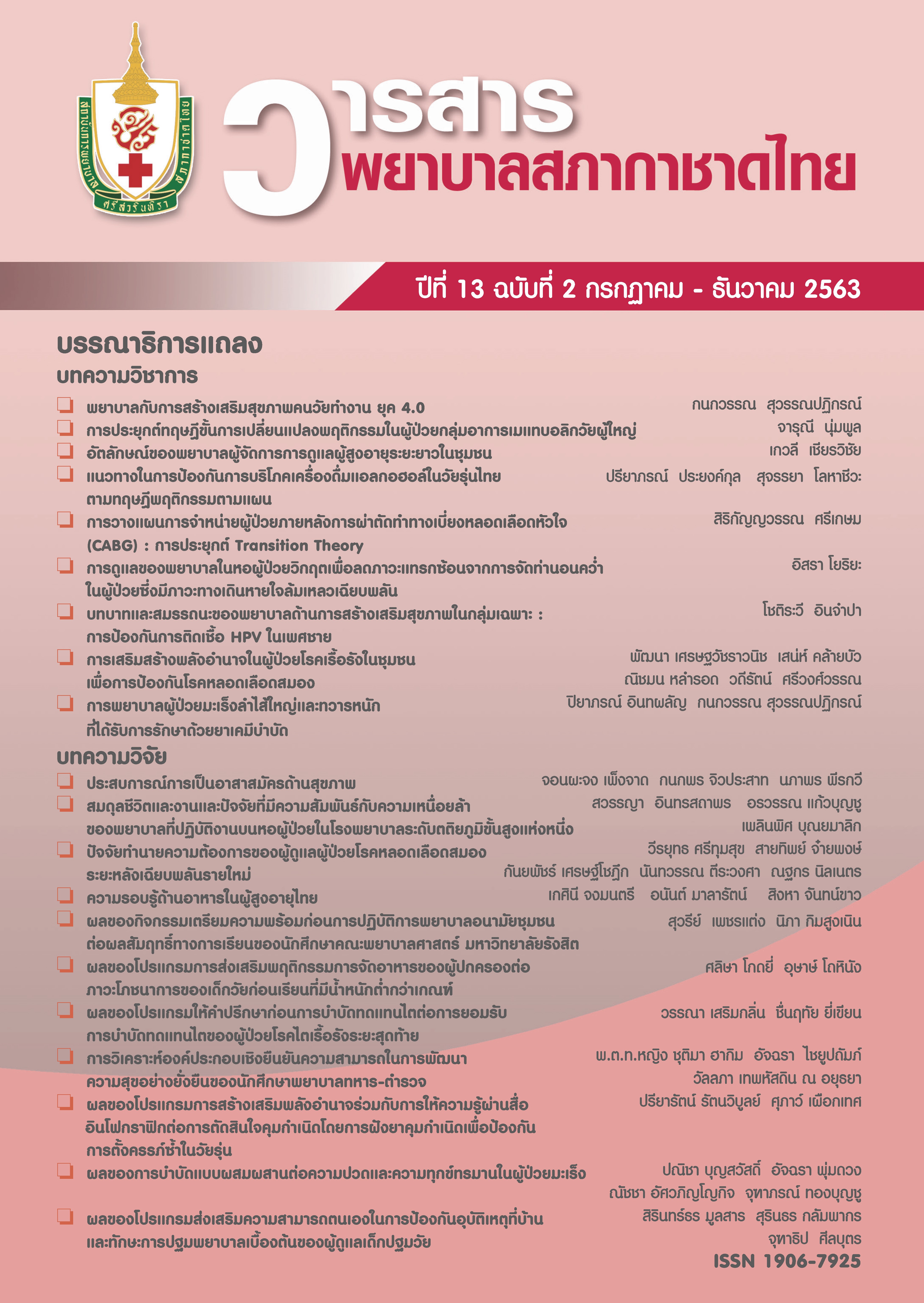Work-Life Balance and Factors Associated with Fatigue Among Nurses in a Super Tertiary Hospital
Keywords:
fatigue, work-life balance, registered nurse, a super tertiary hospitalAbstract
This research is a cross-sectional study applying the Stamm’s compassion fatigue model to study factors associated with compassion fatigue of nurses working in inpatient wards. The samples consisted of 348 professional nurses working in hospital wards. Data were collected by using self-administered questionnaires consisting of 1) person environment; including; personal information, health status, and a work-life balance questionnaire, 2) client environment including; a work load and job description questionnaire, 3) work environment including; a perception of work environment and social support questionnaire, and 4) the fatigue measure questionnaire. The questionnaires were pre-tested with content validity equal to 0.90-1 and reliability with the coefficient value of Cronbach's alpha was equal to 0.76-0.94. Data were analyzed using descriptive statistics, Spearman's correlation coefficient, and simple and multiple logistic analysis statistics.
The research found that most of the samples had compassion fatigue and work-life balance was at a moderate level of I-, 71.3% and 59.8%, respectively. It was found that the factors related to compassion fatigue were 1) personal environment including educational level, sufficiency of income, number of dependence, overall health status, physical health, and mental health, and the work-life balance, 2) client environment including workload, and 3) work environment including physical awareness, biological awareness, chemical awareness and social support. The significant factors were further analyzed for multiple logistics and it was found that the factors that influence fatigue include work and life balance, mental health status, and the awareness of the physical working environment.
An administrator can apply the research results as a guideline for the policy of compassion fatigue management, mental health promotion, and personal and family life balance management for nurses, including for the purpose of encouraging nurses to realize the importance of environmental management and to protect the physical environment in hazardous work that may threaten their health.
References
2. Nick B. Quality environment: examining compassion fatigue, compassion satisfaction. Am Nurse 2015;47(5):14.
3. Gerke ML. Leading nurses like a shepherd. Nurse Leader [Internet]. 2011 [cited 2016 Sep 26];9(3):36-8. Available from: https://doi.org/10.1016/j.mnl.2010.09.006
4. Yen HC. Effect of shift works on workers’, fatique, pressure and health status [Internet]. 2013 [cited 2016 Sep 26]. Available from: https://www.library.ucsb.edu/node/3637
5. Canadian Nurses Association. Fatigue nurse [Internet]. 2012 [cited 2017 Sep 10]. Available from: http://www.nursingworld.org/fatigue
6. Juangtrakul C. Quality of working life. People Magazine 2010;6(1):5-8.
7. Mason VM, Leslie G, Clark K, Lyons P, Walke E, Butler C, et al. Compassion fatigue, moral distress, and work engagement in surgical intensive care unit trauma nurses: a pilot study. Dimens Crit Care Nurs 2014;33(4):215-25.
8. Stamm BH. The concise ProQOL manual [Internet]. 2010 [cited 2016 Sep 26]. Available from: https://www.proqol.org/uploads/ProQOL_Concise_2ndEd_12-2010.pdf
9. Naut’s Medical Tips. Compassion fatigue [Internet]. 2016 [cited 2016 Aug 8]. Available from: https://www.facebook.com/notes/nauts-medical-tips-compassion-atigue/1139235142787342/
10. Perry B, Toffner G, Merrick T, Dalton J. An exploration of the experience of compassion fatigue in clinical oncology nurses. Can Oncol Nurs J 2011;21(2):91-105.
11. Yamma C, Lueboonthavatchai P. Sleep problems, fatigue and work efficiency among registered nurse at King Chulalongkorn Memorial Hospital. J Psychiatr Assoc Thailand 2013;58(2):183-96. (in Thai)
12. Kasemsup W, Thong P, Papha K. Assessment report of 8,000 heart surgery program as a royal 80th birthday anniversary and 84th anniversary of Her Royal Highness Princess Maha Chakri Sirindhorn Her Royal Highness Princess Galyani Vadhana Krom Luang Narathiwat Ratchanakharin. Nonthaburi: National Health Security Office; 2007. (in Thai)
13. Ratanachina J, Rattananupong T, Sithisarankul P. Millennial employees’ work-life balance and associated factors. Chula Med J 2016;60(5):509-21. (in Thai)
14. Nuthabut J. Balancing between life and work: a case study of Vibhavadi Hospital [Thesis]. Bangkok: Thammasat University; 2011. (in Thai)
15. Chatturatkornphat P. The fatigue of navy pilots that affect the safety level of flying operations [Thesis]. Chonburi: Burapha University; 2011. (in Thai)
16. Hunsaker S, Chen HC, Maughan D, Heaston S. Factors that influence the development of compassion fatigue, burnout, and compassion satisfaction in emergency department nurses. J Nurs Scholarsh 2015;47(2):186-94.
17. Junyota A, Chantanakul S, Chaikittiporn C, Siri S. Fatigue and factors related to fatigue among registered nurses in a tertiary hospital. Journal of The Royal Thai Army Nurses 2017;18:166-74. (in Thai)
18. Vichianpradit K. Factors related to occupational stress among registered nurses in autonomous university hospitals [Thesis]. Chonburi: Burapha University; 2013. (in Thai)
19. Arpanantikul M, Putwatana P, Wittayasooporn J. Health status and health practices of Thai nursing students. Thai Journal of Nursing Council 2011;26(4):123-36.
20. Sacco TL, Ciurzynski SM, Harvey ME. Ingersoll GL. Compassion satisfaction and compassion fatigue among critical care nurses. Crit Care Nurse 2015;35(4):32-43.
21. van Mol MM, Kompanje EJ, Benoit DD, Bakker J, Nijkamp MD. The prevalence of compassion fatigue and burnout among healthcare professionals in intensive care units: a systematic review. PLoS One 2015:10(8);e0136955. doi: 10.1371/journal.pone.0136955
22. Perry B, Dalton JE, Edwards M. Family caregivers' compassion fatigue in long-term facilities. Nurs Older People 2010;22(4):26-31.
Downloads
Published
Issue
Section
License
เนื้อหาบทความหรือข้อคิดเห็นต่างๆ ในวารสารพยาบาลสภากาชาดไทยนี้ เป็นความคิดเห็นของผู้เขียนบทความ ไม่ใช่ความเห็นของกองบรรณาธิการ หรือสถาบันการพยาบาลศรีสวรินทิรา สภากาชาดไทย






